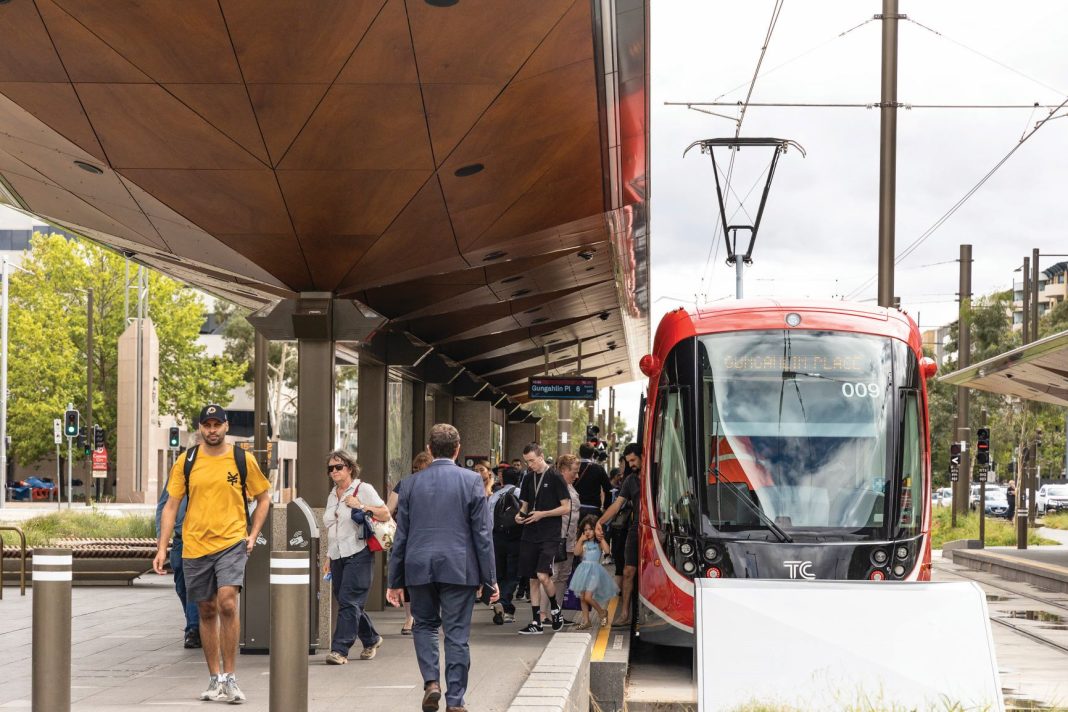The ACT Government promises that better technology, active and real-time management of the traffic network, and more Park and Ride facilities will assist traffic flows and manage disruption, as the new Woden public transport interchange is built, London Circuit is raised midyear – and years of traffic congestion begin.
“This boost in construction activity will be disruptive for our traffic network, and it will impact how Canberrans access the City centre,” said Chris Steel, ACT Minister for Transport.
Once complete, Mr Steel said last year, light-rail would be a congestion-busting tool, a mass transit line to the south. The network will originally connect all the ACT – necessary given the government believes Canberra’s high level of car dependency is unsustainable. A predicted population of 620,000 by 2046 will result in a congested road network, while smart public transport will make Canberra liveable and competitive, according to their transport plan.
Similarly, Chief Minister Andrew Barr expects the light rail project – the ACT’s biggest ever infrastructure build – will create thousands of jobs and support Canberra’s economic recovery.
But extending the light rail line south to Woden would also create traffic jams and shut down major arterial roads for at least four years, Mr Steel revealed last year.
The government will raise London Circuit to the level of Commonwealth Avenue, demolish bridges on the Avenue and overpasses over the Circuit, and fill in 60,000 cubic metres.
As a result, Commonwealth Avenue will be almost unnavigable until 2026, while peak hour traffic on other roads will increase by more than half, increasing commutes by 15 minutes.
The ACT Government will install intelligent transport monitoring technology in strategic locations across central Canberra where disruption and congestion are likely, Mr Steel said today.
This will include new intersection cameras and Bluetooth sensors that feed information on traffic back to the central Traffic Operations Centre at Fyshwick.
Data from these devices will provide up-to-date information about journey times and potential disruption through wireless variable message signage on the roads, via radio and social media.
Active monitoring of the network will also mean a faster response to accidents or issues before they cause major congestion.
“Providing reliable information in real time will mean commuters can make informed choices before or during their trip,” Mr Steel said. “This might mean choosing a different route, traveling at a different time, or jumping on public transport.”
Mark Parton, Shadow Minister for Transport (Canberra Liberals), is appalled Canberrans will be in a traffic gridlock for the next few years, and have to “rejig their lives” for the project.
“This city is about to experience long-term traffic disruption of biblical proportion, and no amount of additional information will spare Canberra’s commuters from immense pain,” he said today.
“It’s pleasing that this mechanism will be available, but I would reiterate that the disruption that we are about to experience will be unprecedented.”
Today, Mr Steel said the traffic information was “just one of the ways” the Government will help “Canberrans to rethink their routes and rethink their routines” during major infrastructure works.
The government will build a park and ride facility at Beasley St, Mawson, which Mr Steel said would help more people on the southside use public transport and avoid congestion.
Seventy car parks will be converted to park and ride spaces. A footpath will link the Rapid routes on Athllon Drive, and lighting will improve safety.
All users of Mawson Playing Fields would have better public transport access on weekdays, after hours, and on the weekend, Mr Steel said.
These projects build on other recent ACT Government investments to manage disruption and keep the city moving during infrastructure projects, Mr Steel said: signalising the Coranderrk Street roundabout to improve traffic flows from Parkes Way for people accessing the city from the southside and Belconnen, and installing bus priority signals at Vernon Circle.
Approvals for these upgrades are with the National Capital Authority.
The ACT Government has also sought feedback from the public and local businesses through surveys and roundtables about how to minimise the disruption.
However, the light rail project has been dogged by problems. Last year, the Auditor-General criticised the business case and economic analysis for the first stage, Civic to Commonwealth Park; capital costs would be higher than the government estimated, and many of the benefits claimed depended on other projects.
Last year, Mr Parton was concerned millions of taxpayer dollars were being spent on the light rail project that had seen serious safety issues in other jurisdictions; the same model of tram used in Canberra had cracked in NSW, leading to the immobilization of the fleet for 18 months, as it had in Europe. Mr Steel promised the vehicles would be checked for cracking, and accused Mr Parton of trying to undermine light rail.



